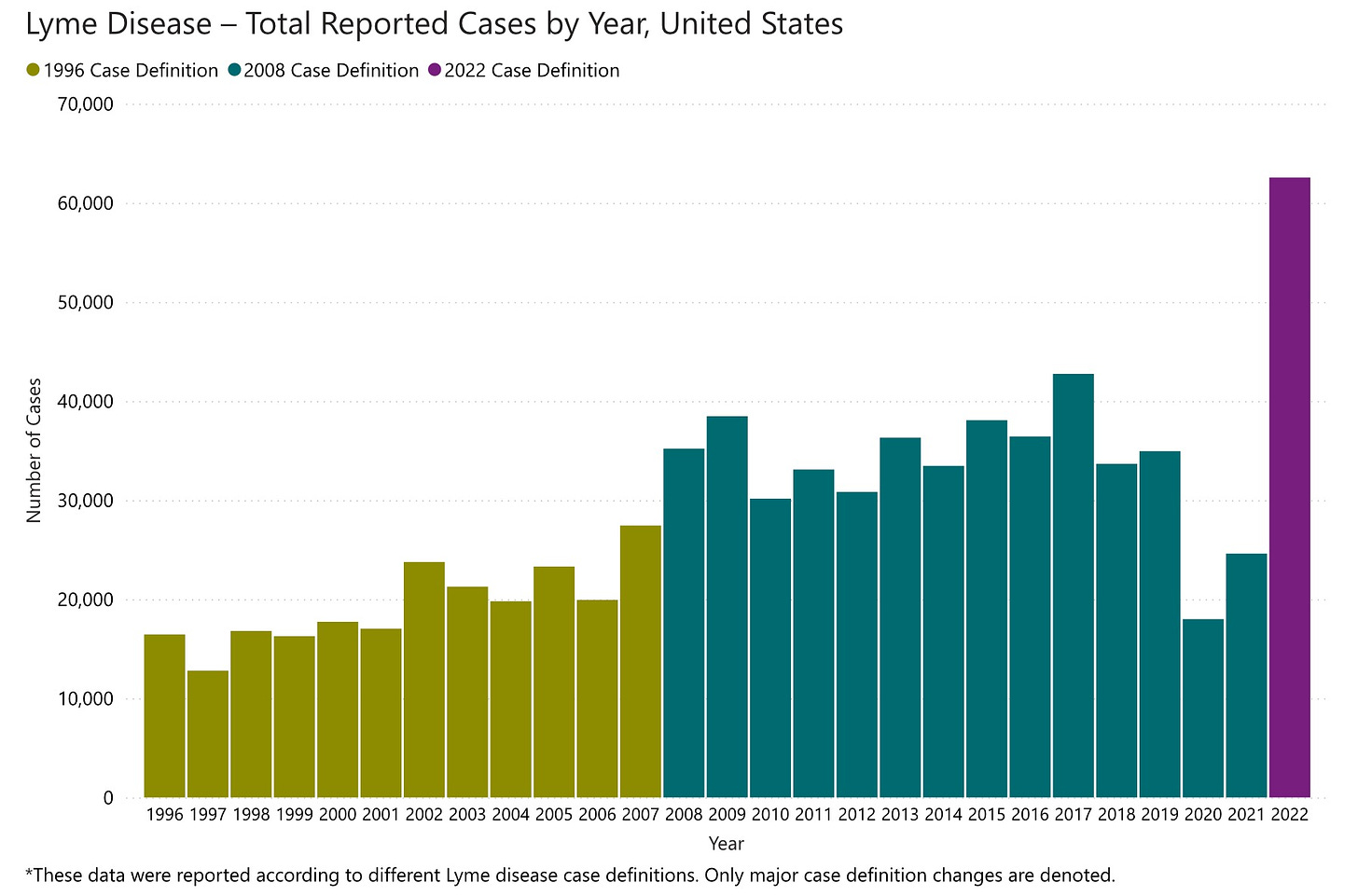True Crime as True Lyme: Tick Bite Leads to Murder-Suicide
Tortured by Lyme disease, a young man killed his friend and himself. He is not alone.

For decades, Lyme disease physicians have seen a small share of late-stage patients with symptoms far beyond the physical ravages of a tick bite. These patients, estimated to be 1 percent of chronic Lyme psychiatric cases, manifest brain disorders so intractable that they become violent, even homicidal.
Now, a new article in the science journal Heliyon validates these observations and reveals possible mechanisms driving them. It tells the horrific story of a 32-year-old man whose tickborne infection at age 14—one of several—went unrecognized until it was unresponsive to treatment. Failed by short-course antibiotics that mainstream medical guidance swears by, he descended into substance abuse, as many chronic Lyme patients do, to ease his anxiety, depression, and physical pain.
Finally, in the delusional throes of PCP withdrawal, he walked next door, impulsively killed his best friend, stabbed the friend’s father and brother, and turned the knife on himself. He died on a bathroom floor, his mother having tried in vain to stanch two neck wounds.
All of this is a likely outcome of poorly treated Lyme disease under medical protocols that leave even early-treated patients sick—36 percent at six months and 5 percent at fifteen years. While animal studies and a handful of post-mortem reports have illustrated the failure of recommended treatments to quell Lyme disease—using antibiotics in insufficient strength or duration—this study goes further.
For the first time, based on analysis of autopsy samples, it shows both how persisting infection combined with chemical brain changes from substance abuse may have contributed to a disastrous outcome.
I am withholding the man’s name for reasons of respect and privacy. I will call him Michael.
Just one case? Unlikely
The conclusions of the peer-reviewed study, supported by laboratory analysis at Tulane and Columbia universities, are groundbreaking not only for what they found in Michael’s organs and brain.
The graver implication is that Michael is most certainly not a singular case.
Some half-million Americans are estimated to be treated for Lyme disease yearly. Published studies link advanced, poorly treated Lyme disease to impulsive behavior, mental illness, suicide, and homicide. Indeed, microbes have long been associated with mental disorders and psychosis, most famously syphilis, a spirochete like Lyme.
This case suggests, and experts strongly suspect, that other acts of violence—from single homicides to mass shootings—could potentially be traced back to a disease with inadequate diagnostic tests and treatments, and media and medical messages that underestimate its severity: Lyme.
“I’ve dealt with too many of these cases,” said Dr. Robert Bransfield, lead author on the study and a psychiatrist-consultant on about twenty cases of attempted and actual murders involving defendants with Lyme histories. On the day I spoke with him, Bransfield received calls from criminal lawyers in two cases, one a homicide, with possible Lyme connections. Another psychiatrist who treats Lyme disease told me of two patients who seriously harmed their mothers.
Bransfield sees similarities between cases he has dealt with and mass shooters like Adam Lanza, who killed twenty children and six adults at Sandy Hook Elementary School in 2012. He also killed his mother and himself.
Lanza lived amidst Connecticut’s infamously high Lyme rates and suffered what an investigative report called “completely untreated” mental illness. Nonetheless, the role of possible infection was not mentioned in the report and likely not explored. Since at least 2015, the American Psychiatric Association has recommended that evaluations for mental illness include assessments of “locally endemic infectious diseases such as Lyme disease.”
They are seldom done.
News reports of Michael’s murder-suicide, typically, said it stemmed from a “dispute” and an “altercation,” reducing a two-decade struggle against disease to a simplistic sound bite.
“I personally believe that this case report is not a lone or rare incident,” said Dr. Rosalie Greenberg, a published Lyme psychiatrist who specializes in children and adolescents. “Some support exists indicating Lyme and tick-borne illnesses may have played a role in more than one mass shooting.”
Bransfield, who has published many articles on the effects of Lyme disease on the brain, agrees.
“They ought to look at this the way they look at a plane crash,” he told me. “Analyze and dissect the problem. Fix the system.”

Family sought answers
After their unspeakable tragedy—and the grief it caused another family—Michael’s parents wanted to know: Did Lyme disease play a role? Dr. Bransfield, who was going to treat Michael when his waiting list allowed, contacted Tulane’s Dr. Monica Embers. Her previous studies had found Lyme spirochetes in the brains and organs of rhesus macaques long after common antibiotics should have eliminated them. In Michael’s heart and pancreas, Embers also found Borrelia bacteria, in the relapsing fever branch of Lyme disease as opposed to classic Borrelia burgdorderi.
But as significant, his brain was a battlefield of inflammation and abnormal biochemical markers, including a harmful neurotoxin called quinolinic acid that interferes with brain signaling. Late Lyme disease has long been known to promote the toxin; PCP reduces it. Michael’s abrupt withdrawal from the drug, researchers concluded, created a “perfect storm (that) . . . could have drastically increased his risk of violent and suicidal behavior,” said an announcement of the publication by Tulane.
Embers’ previous studies had defied medical dogma on the reliability of standard Lyme treatments. The newest findings show those treatments also failed Michael, a once-healthy child who had an IQ of 148, read voraciously, and liked to write and draw. The problem was that he grew up in places that have, in the last fifty years, become riddled with disease-toting ticks, making a walk outdoors a risky endeavor.
As a toddler, he was treated for a week with amoxicillin after a tick-bite and rash. Ticks were found on him at least fifteen times, including three imbedded in his skin. At 14, he “developed a summer flu-like illness,” the article states, “which the pediatrician considered a virus not needing antibiotics,” despite an attached tick.
In research for a book on Lyme disease, I heard many similar stories of medical denial and neglect. Science journals, I found, warned doctors against overusing antibiotics because of the risk of falsely positive tests while ignoring a more consequential danger of tests that were wrongly negative. Many chances to eliminate the infection early were, and still are, missed.
Michael’s early tests of IgM antibodies never met the threshold of two out of three Lyme indicators, or “bands” on a Western blot test, although separate tests taken together did. His late-stage IgG test scored four of the required—and arbitrary—five bands. Ultimately, the treatment he received years after infection, Bransfield said, was “too little, too late.”
“This patient was inadequately diagnosed and treated, felt desperate, and turned to substance abuse for relief from multiple late-stage symptoms,” the article states. Michael’s mother said her son used PCP intermittently when he wasn’t receiving treatment, and it helped him. “Anxiety disappeared,” she told me. “He would become relaxed, less shy . . . tasks and things became easy again.”
Two days before his death and six days since last taking PCP, Michael sought, and was denied, a bed in a substance abuse rehabilitation facility. On an early fall evening in 2021, “he walked to his best friend’s house, began talking in a delusional manner, and became acutely aggressive. He committed a homicide, assaulted 2 others, and then committed suicide at age 32,” the article states.
PCP withdrawal, the article said, brings on “fear, agitation, anxiety, irritability, restlessness, flashbacks (intrusive symptoms), sweating, headache, hallucinations, seizures and hyperactive eye movements.” Such eye movements had been seen in Michael.
Mind and body pain
Bransfield’s own study described the everyday pain of fifty Lyme psychiatric patients who, like Michael, developed homicidal tendencies: “Cognitive impairments (100%), musculoskeletal symptoms (100%), fatigue (97%), depression (97%), generalized anxiety (90%), neurological symptoms (86%), anhedonia (72%), pain (57%), and social anxiety (55%).” Anhedonia is the inability to feel pleasure.
Another analysis of 100 documented late-stage Lyme patients found that 1 percent had substance abuse problems before infection. Afterward, 12 percent did.
“Part of it is you’re lost in the system,” Bransfield said, echoing the words of Michael’s mother. “They go to doctors and don’t get help and they turn to substances. They die from opioid overdoses, a lot of them die.” Sometimes they take others with them.
Former President Trump was shot on July 13 by a 20-year-old man from Pennsylvania, who lived in a high-Lyme county in the state with the nation’s ninth-highest incidence of Lyme disease. In an email chain among colleagues, a physician commented recently: “I hope the young man’s body will be examined with that in mind.”
Michael’s mother contends that it is simplistic to say her son’s substance abuse was the trigger for what ultimately happened. His case, including a final tick bite in 2019 that greatly worsened his symptoms, is too complex for that.
“If he had been treated at some point in those years,” she wrote in an email, “he would not have broken and he and [his friend] would be here.”
Mary Beth Pfeiffer is an investigative journalist and author of “Lyme: The First Epidemic of Climate Change.” Read her Covid-19 and Lyme articles here.





If the biowar-pharma complex that created this mess could work on a real solution (eradicating these pathogens from the tick populations), that would be great.
The reason they eliminated antibody test bands from the diagnostics, reducing the usefulness of the lyme tests, is because their failed lymerix "vaccine" caused (false positive) responses on those bands, and it would have been bad PR for the vaccines (which were shortly withdrawn due to serious adverse events).
Growing up on Long Island, NY in the 80's and 90's, I and my friends spent a lot of time in the woods. There was worry then of "rocky mountain spotted fever", but lyme was silently spreading out there, courtesy of the birds carrying infected ticks back from the Plum Island "agricultural" (biowarfare) lab. Picking out ticks was pretty routine... though we got pretty good about avoiding them, between staying out of the grass, watching out for overhanging vegetation on the trails, and clearing the favorite trails by hand with a machete. Similarly, we'd relentlessly check for ticks on our clothes. They wait on the edges of grass and vegetation, and stick to your clothes when you brush up against them. Then they climb up, usual spots if they embedded were above the pants line, so usually from the belly, chest, armpits... to the neck, ear, scalp. Note that the Plum Island operations were so sloppy and dangerous they finally were forced to close. So they built a new one in Manhattan KS, right in the heartland of cattle country.. "to study infectious cattle diseases" like hoof and mouth disease. Another "convenient" disaster waiting to happen!
See also:
The Quiet Epidemic (2022, documentary)
Bitten The Secret History of Lyme Disease and Biological Warfare by Kris Newby
Lab 257: The Disturbing Story of the Government's Secret Germ Laboratory
Carroll, Michael C., William Morrow & Company
Amazing article, really appreciate knowing about this.